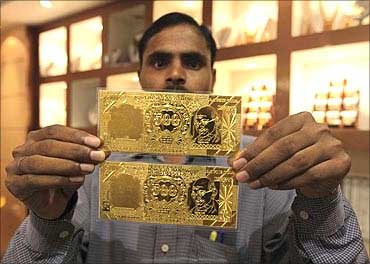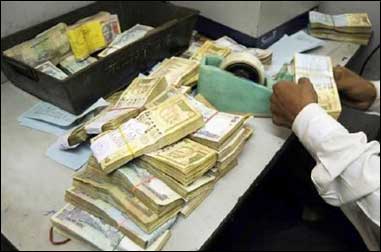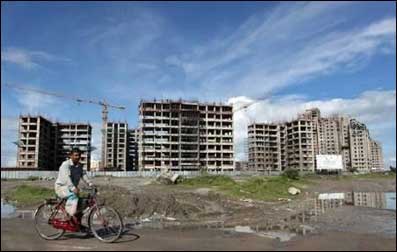This article was first published 14 years ago
Fiscal deficit: It's time to end stimulus
Last updated on: March 2, 2011 16:26 IST
Image: Huge fiscal stimulus, a burden.
Photographs: Reuters.
The perplexing question that must puzzle many is why, in the face of a huge fiscal stimulus (the highest in more than a decade), no one thinks that the government has done enough.
The answer to that puzzle might explain why so many people are disappointed at the fact that the Interim Budget has not offered goodies for distressed businesses (ignoring for a moment the operative point that the government's agenda was nothing more than a vote-on-account for four months).

Image: Fiscal deficit burden.
Photographs: Reuters.
The straight numbers on the fiscal deficit are impressive enough, having more than doubled from 2.7 per cent of GDP in 2007-08 to 6 per cent this year.
Given that another 1.8 per cent of GDP has been dished out by the government in the form of "special securities", the size of the total stimulus is 7.8 per cent of GDP-not far behind the 8.5 per cent that the US is expected to do this year.

Image: Small and marginal farmers may borrow or spend a little more.
Photographs: Reuters.
The problem is that businesses have not seen most of this money. The subsidy on petroleum products and fertiliser has gone mostly to suppliers overseas. The farm loan waiver has removed the burden of debt from their shoulders.
Small and marginal farmers may borrow or spend a little more as a result, but the impact is likely to be much less than the debt written off. In any case, no one has argued that the problem this year is a lack of rural demand.

Image: Agriculture accounts for less than a fifth of the total GDP.
Photographs: Reuters.
After four years of 3.7 per cent annual growth in the agricultural output, and an increase of about 60 per cent in wheat and rice procurement prices, farmers are not the people who have cut back on spending. But this has little visible impact because all of agriculture accounts for less than a fifth of the total GDP.
The doubling of expenditure under the rural employment guarantee scheme, similarly, will do nothing for the troubled sectors of industry since people below the poverty line, who benefit from the guarantee programme, are unlikely to spend on anything other than the basics - food and some clothes.

Image: 150 per cent increase in government borrowing this year.
Photographs: Reuters.
In other words, the bulk of the additional deficit incurred during the year will have done little for the automobile, construction, travel and other troubled sectors.
If anything, the 150 per cent increase in government borrowing this year (which is the result of the additional spending) has substantially sucked out the additional liquidity pumped into the system by the Reserve Bank through reductions in the cash reserve ratio.

Image: Reserve Bank of India logo.
Photographs: Reuters.
In other words, the RBI's attempts to push out more money and force down interest rates may have been stymied in part by the government's borrowing/spending programme.
The truth about the deficit, therefore, is that it is designed to serve political objectives, not economic ones. That is why it is hard to argue that the deficit translates into a stimulus for the troubled sectors.

Image: Petro-product prices subsidised.
Photographs: Reuters.
Indeed, it might be said that if the government had not spent all that money, and had focused more on containing expenditure so that interest rates fall more, the sectors that have been hit by high interest rates (automobiles, real estate, consumer durables) might have fared better.
This argument has its limits, of course. If petro-product prices had not been subsidised, car and truck sales would have collapsed anyway in the wake of higher petrol and diesel prices.

Image: Brick factory workers.
Photographs: Reuters
In any case, business will be reluctant to nay-say the political argument that it is the aam aadmi who has been in urgent need of government help. It could argue that one should not be at the expense of the other, but we are not dealing with limitless resources.
Still, the new reality of recent weeks is that total commercial bank lending has begun to shrink. The demand for power too seems to be reducing.
These are virtually unprecedented trends, and point to the seriousness of the business situation that is masked by the macro-talk of 7 per cent GDP growth.

Image: A vendor strings marigold flower garlands.
Photographs: Krishnendu Halder/Reuters.
The question is whether more of a fiscal stimulus is the answer, since that will translate into more deficits, more government borrowing and therefore more pressure on interest rates, or whether fiscal restraint will facilitate lower interest rates which then help revive demand and business activity.
It is not an easy choice to make, but businessmen and economists have some thinking to do before beginning to lobby whichever government comes into office after the elections.

Source:









